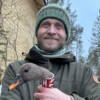Breeding waterbirds of oligotrophic lakes
Summary
The populations of waterbirds breeding in oligotrophic inland waters have declined. Populations were stable in the early years of the monitoring period, but have since decreased. The darkening of water bodies and the loss of visibility have been found to have a negative impact on breeding bird populations in oligotrophic inland waters. Individual species have both clearly increasing and decreasing populations.
Status
The status of the indicator is satisfactory. With 90 percent certainty, the breeding bird populations in oligotrophic inland waters are at least 7.6% lower than at the beginning of the monitoring period (1986-1990).
Trend
The indicator has a declining trend. With 90 percent certainty, breeding bird populations of oligotrophic inland waters have declined by at least half a percent per year in the 2000s (point estimate 0.8 percent; Piha et al. 2023). In the early years of the period (1986-1999), populations were stable on average, and the sharpest decline seems to have occurred between 2000 and 2010. Over the last 13 years (2010-2023) the indicator has been stable.
Individual species have both clearly increasing and decreasing populations. For example, the population of the whooper swan increased strongly during the monitoring period. However, an increase in the abundance of the whooper swan is not linked to a decline in other species (Holopainen et al. 2022). Also, the common loon has increased in abundance over the last 10 years. The mallard has increased in abundance over the long term, but no longer in the last 20 years. Populations of the other important game bird species, the common goldeneye and Eurasian teal, have declined over the long term. Species-specific population trends can be found in the annual waterbird surveys published by the Natural Resources Institute Finland, see for example Piha et al. (2023).
Significance
This indicator describes the state of biodiversity in inland waters. The population trend of inland birds indicates the viability of the species. Locally, this is reflected in the diversity and abundance of inland birds.
The bird surveys constitute one of the most reliable monitoring data on biodiversity in Finland (see “Data used” below). In addition, the habitat needs of birds are well known compared to many other species groups. Thus, such bird species can be identified whose population trends are closely linked to the status of oligotrophic inland waters.
The darkening and loss of visibility of water bodies has been shown to have a negative impact on waterbird populations. However, population fluctuations are not only explained by changes in habitat conditions, but are also influenced by factors such as conditions in wintering areas and along migratory routes, climate change, natural predation pressure and hunting pressure throughout the species’ range.
The indicator species that are currently hunted contain: Eurasian widgeon, Eurasian teal, mallard, common goldeneye, tufted duck and goosander.
References
Data used
The indicator is based on monitoring censuses coordinated by the Natural Resources Institute Finland and the Finnish Museum of Natural History and carried out by volunteer hunters and birdwatchers. The indicator for inland waterbirds is based on waterbird census data dating back to 1986.
The indicator includes three common species that nest in oligotrophic lakes and six common species that nest in both oligotrophic and eutrophic lakes. The goosander, red-breasted merganser and common loon breed almost exclusively in oligotrophic lakes. The data of the whooper swan, mallard, Eurasian teal, common goldeneye and tufted duck were included from oligotrophic monitoring sites.
Species included in the indicator:
Eurasian widgeon – Anas penelope
Goosander – Mergus merganser
Common loon – Gavia arctica
Whooper swan – Cygnus cygnus
Mallard – Anas platyrhynchos
Eurasian teal – Anas crecca
Tufted duck– Aythya fuligula
Common goldeneye – Bucephala clangula
Red-brested merganser – Mergus serrator
More information:
Indicator calculation
The Inland Breeding Bird Indicator is an indicator produced by the Natural Resources Institute Finland, which combines estimates of population trends of individual species into a single index number following the principle developed earlier by Lehikoinen et al. (2016). The index number describes the relationship to the reference year, which for the inland waterfowl indicators is 1995. A more detailed description of the calculation methods can be found in the Natural Resources Institute Finland’s report on waterfowl monitoring (Piha et al. 2023).
The calculation of the multispecies indicator starts with an assessment of the population trends of individual species. Species population trends are estimated from the number of bird pairs observed in the censuses using Bayesian generalised mixed models (GLMM), which take into account differences between census sites and density differences between sites (see Piha et al. 2023).
Species-specific estimates based on sampling-dependent statistical models always contain uncertainty. This uncertainty is evaluated by Monte Carlo simulations and incorporated it into the multispecies indicator.
More information:
Ask for further information

Aleksi Lehikoinen
Senior Curator (Luomus), Head of the working Group on Birds
